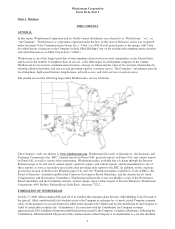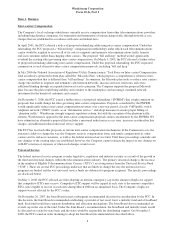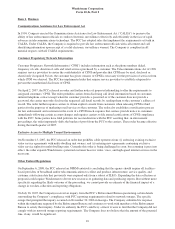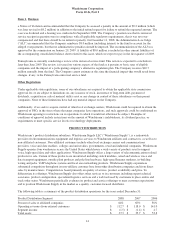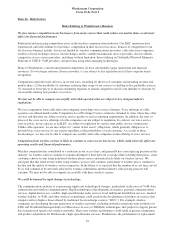Windstream 2008 Annual Report Download - page 55
Download and view the complete annual report
Please find page 55 of the 2008 Windstream annual report below. You can navigate through the pages in the report by either clicking on the pages listed below, or by using the keyword search tool below to find specific information within the annual report.
Windstream Corporation
Form 10-K, Part I
Item 1. Business
offerings. As of December 31, 2008, the Company could deliver speeds of 3Mb to 97 percent of its addressable lines.
Additionally, speeds of 6Mb and 12Mb are available to 61 percent and 32 percent of its high-speed Internet addressable
lines, respectively.
During 2008, the Company added approximately 107,000 high-speed Internet customers. This increased the
Company’s high-speed Internet customer base to over 978,000 customers at December 31, 2008, which represents a
penetration rate of 32 percent of total access lines in service, and 44 percent of residential access lines in service.
Although high-speed Internet services have been a source of revenue and customer growth for Windstream, that service
offering experiences competition primarily from high-speed Internet offerings of cable competitors. In addition, we
could experience some increased competition from high-speed Internet offerings of wireless competitors.
SEASONALITY
Our business is not subject to significant seasonal fluctuations.
REGULATION
Our incumbent local exchange carrier subsidiaries (collectively the “ILECs”) are regulated by both federal and state
agencies. Our interstate products and services and the related earnings are subject to federal regulation by the Federal
Communications Commission (“FCC”) and our local and intrastate products and services and the related earnings are
subject to regulation by state Public Service Commissions (“PSCs”). The FCC has principal jurisdiction over matters
including, but not limited to, interstate switched and special access rates, as well as high-speed Internet service
offerings. It also regulates the rates that ILECs may charge for the use of their local networks in originating or
terminating interstate and international transmissions. The PSCs have jurisdiction over matters including local service
rates, intrastate access rates, quality of service, the disposition of public utility property and the issuance of securities
or debt by the local operating companies. As a regulated entity, the Company is required to comply with various
federal and state regulations.
Communications services providers are regulated differently depending primarily upon the network technology used to
deliver the service. This patchwork regulatory approach advantages certain companies and disadvantages others. It
impedes market-based competition where service providers using different technologies exchange telecommunications
traffic and compete for customers.
From time to time federal legislation is introduced dealing with various matters that could affect our business. Most
proposed legislation of this type never becomes law. It is difficult to predict what kind of reform efforts, if any, may be
introduced in Congress and ultimately become law. Windstream strongly supports the modernization of the nation’s
telecommunications laws, but at this time, cannot predict the timing and the resulting financial impact of any possible
federal legislative efforts.
FEDERAL REGULATION
Price Cap Petition Granted by FCC
On March 18, 2008, the FCC granted a petition filed by Windstream on August 7, 2007, to convert the majority of its
remaining interstate rate-of-return regulated operations to price cap regulation effective July 1, 2008. Price cap
regulation better aligns with the Company’s continued efforts to improve its cost structure. Under price cap regulation,
rates for interstate wholesale services are not required to be periodically adjusted based on the Company’s cost
structure, and high-speed Internet services can be deregulated resulting in lower USF assessments for our customers.
The Company deregulated its high-speed Internet services on July 1, 2008. Prior to July 1, 2008, many of our interstate
ILEC operations, consisting primarily of network access services, were subject to rate-of-return regulation by the FCC.
Only our Nebraska and New Mexico operations, and a portion of our Kentucky, Oklahoma and Texas operations, were
subject to price cap regulation prior to that date. However, as a result of the FCC’s March 18th order, the vast majority
of the Company’s remaining ILEC operations converted to price cap regulation on July 1, 2008.
7







